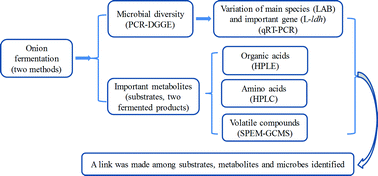Microbial diversity and flavor formation in onion fermentation
Abstract
Fermented onion products are popular in many countries. We conducted fermentation with and without salt to identify the microorganisms responsible for onion fermentation and the unique taste of fermented onion. The results of PCR-DGGE (polymerase chain reaction-denaturing gradient gel electrophoresis) revealed that lactic acid bacteria (Lactobacillus zymae, L. malefermentans, L. plantarum), acetic acid bacteria (Acetobacter pasteurianus, A. orientalis), citric acid bacteria (Citrobacter sp., C. freundii), and yeasts (Candida humilis, Kazachstania exigua, Saccharomyces boulardii) were the dominant microorganisms involved in onion fermentation. Organic acid analysis indicated that lactic acid and acetic acid significantly increased after fermentation. There were no significant changes in the types of amino acids after fermentation, but the total concentration of amino acids significantly decreased after fermentation with salt. The increase in esters, alcohols, and aldehydes after fermentation was responsible for the unique flavor of fermented onion. Fermentation with salt inhibited the accumulation of organic acids and limited the conversion of proteins into amino acids but maintained the unique odor of onion by limiting the degradation of sulfur-containing compounds.


 Please wait while we load your content...
Please wait while we load your content...